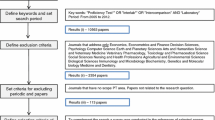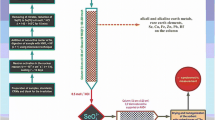Abstract
Since the advent of the Guide to the Expression of Uncertainty in Measurement (GUM) founding the principles of uncertainty evaluation, numerous projects have been carried out to develop alternative practical methods when it is impossible to model technical or economical aspects of the measurement process. These methods can use all the experimental data available to the laboratories, such as repeatability, reproducibility, quality-control charts, etc. The studies presented in this paper compare the results obtained by the modelling method from GUM with the uncertainties found by applying alternative methods. They show two examples, one in the field of environmental monitoring, the other in the biomedical field, based on the exploitation of PT schemes results.


Similar content being viewed by others
References
ISO/IEC 17025 (2005) General requirements for the competence of testing and calibration laboratories. ISO, Geneva
ISO/IEC (1995) Guide to the expression of uncertainty in measurement. ISO, Geneva
Eurolab technical report no. 1/2007 (2007) Measurement uncertainty revisited: alternative approaches to uncertainty evaluation. Eurolab aisbl http://www.eurolab.org
Désenfant M, Priel M (2006) Measurement 39:841–848
ISO 5725 Accuracy (trueness and precision) of measurement methods and results, (6 parts) ISO, Geneva
ISO (2007) International vocabulary of metrology—basic and general concepts and associated terms (VIM), 3rd edn. ISO, Geneva
AFNOR FD X43-070-1 (2007) “Qualité de l’air—guide pratique pour l’estimation de l’incertitude de mesure des concentrations en polluants dans l’air ambient—généralités” http://www.afnor.fr
AFNOR FD X43-070-2 (2007) “Qualité de l’air—guide pratique pour l’estimation de l’incertitude de mesure des concentrations en polluants dans l’air ambient—estimation des incertitudes sur les mesurages automatiques de SO2, NO, NO x , NO2, O3 et CO réalisés sur site” http://www.afnor.fr
Guide méthodologique pour l’estimation des incertitudes en analyse chimique, Rivier C, Lalere B (2003) http://www.lne.fr/fr/services_ligne/publications-guides-documents-techniques.asp
Lab GTA 14 (2006) “Guide d’evaluation des incertitudes de mesure des analyses de biologie medical” http://www.lne.fr/fr/services_ligne/publications-guides-documents-techniques.asp
ILAC-G17 (2002) “Introducing the concept of uncertainty of measurement in testing in association with the application of the standard ISO/IEC 17025” ILAC
Thompson M, Ellison SLR, Wood R (2006) Pure Appl Chem 78:145–196
ISO 13528 (2005) Statistical methods for use in proficiency testing by interlaboratory comparisons. ISO, Geneva
Priel M, Amarouche S, Désenfant M, De Graeve J (2007) “Utiliser les résultats des essais d’aptitude—dernière méthode alternative pour l’évaluation des incertitudes—Application à la biologie médicale”, proceedings of 13 Congrès international de métrologie, Lille, 2007
Author information
Authors and Affiliations
Corresponding author
Additional information
Presented at BERM-11, October 2007, Tsukuba, Japan.
Rights and permissions
About this article
Cite this article
Fisicaro, P., Amarouche, S., Lalere, B. et al. Approaches to uncertainty evaluation based on proficiency testing schemes in chemical measurements. Accred Qual Assur 13, 361–366 (2008). https://doi.org/10.1007/s00769-008-0402-x
Received:
Accepted:
Published:
Issue Date:
DOI: https://doi.org/10.1007/s00769-008-0402-x




